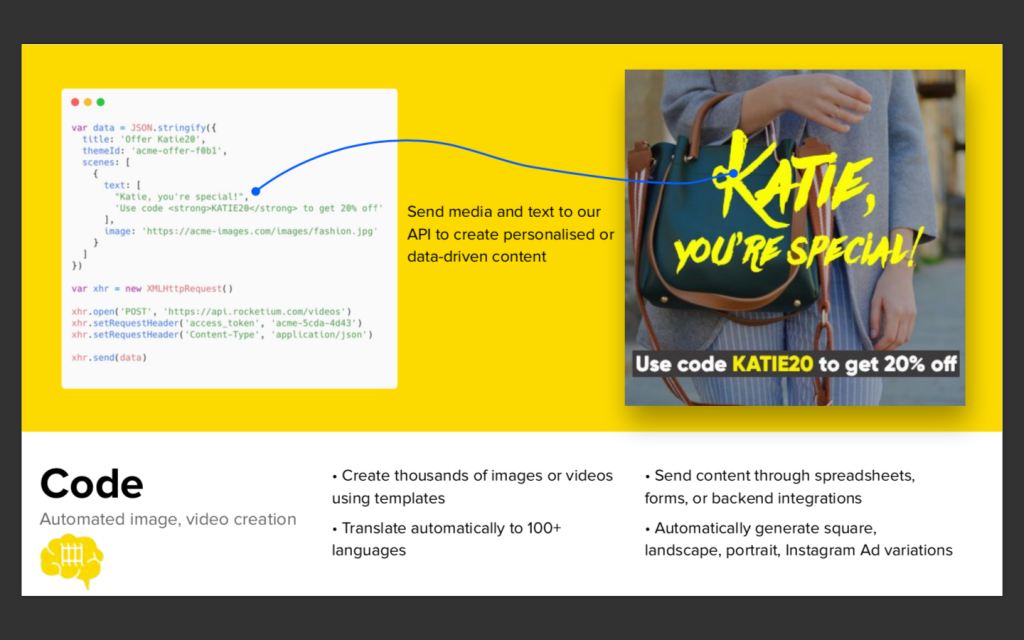Rocketium’s Business Runs on Postman…and So Can Yours
“Import the collection into your workspace.”
“Export the code into a language of your choice.”
“Make sure you change the API key before you make your requests.”
If you had to guess, you would say these quotes are from developers sharing tips on how to use APIs with Postman. In most companies, this would be true. But at Rocketium, this could just as easily be a sales rep, account manager, customer support person, or any of the five other business roles we have. Since the launch of our video and image creation API, such talk is not the exclusive domain of our devs. And Postman plays a significant role in this iteration of our business. Like the Postman team, we believe that most businesses will offer their core platform through APIs. We hope that our lessons will be useful in such a journey.
Our journey to an API-first company
Rocketium launched in 2016 as an easy online video creator. Over the next two years, we added collaborative capabilities similar to Postman – teams, workspaces, comments. Our product was mostly built for marketers. Towards the end of 2018, we started getting requests from developers and product owners, who wanted an API to create templated videos at scale without a user interface. That is when we launched our video and image creation API.
Until this point, our ads, landing pages, pricing, onboarding, and sales funnel was tailored for marketers. In the 6 months after the launch of our API, we saw enough traction from our API that we decided to make it a core pillar of our business. This led to us revising all our customer-facing work to be API-first.
As our API became the center of all our customer conversations, Postman started becoming more and more critical to our operations. It has now permeated all business discussions and lubricated our marketing, sales, and support processes.
Marketing + Postman: material made better
Our main landing page starts with sample videos and code snippets showing how each video can be created with our API.
Our marketers created these videos using Postman. They also copied code generated by Postman to use in the landing page.
We also use code snippets liberally in product marketing material like decks, webinars, and e-books. Our marketers take code from Postman and generate images from the code with this cool tool.

A lot of our marketing effort goes into our API documentation. We think of documentation as marketing material for developers. Well-written doc writers put themselves in the shoes of the developer, answer the top queries they might have, and preempt common pitfalls.
Code samples are a big part of our documentation. We use Postman’s nifty code generation feature to get code in multiple languages and use it in our documentation.
| Pro Tip: We put together our doc page with Slate, which uses a simple Markdown-based declarative syntax. Sublime has a nice Markdown preview command to see how your docs look before deploying. |
Sales + Postman: demos and pilots done right
The goal of our demos is to show developers and product owners how easy it is to create videos and images at scale with Rocketium. Our sales rep starts by showing a few impressive videos and then jumps right into Postman to show how code can be used to create these videos. The feeling of going from code to video is something that cannot be matched by a deck or any amount of talking.
After demos, some leads want to try our API to create a few videos on their own. Though we allow users to create their own API key and export code for their videos, some leads want to create videos for specific use-cases. To address this and equip our sales rep, we created a shared Postman collection with a master list of requests. Our sales rep cherry-picks the relevant requests, fills in the customer’s API key, and shares the collection with them. Most customers are already Postman users so this eases the pilot. In many cases, we introduce product and business teams to Postman who are amazed at how a simple command can create complex videos like these.
| Pro Tip: We have a master collection in which we have sample requests for different APIs and different uses of a given API. Every API request is authenticated with an API access token, which we leave blank in all requests in our master collection. |
Account management + Postman: smoother onboarding and support
The back-and-forth we experienced during pilots was nothing compared to what used to happen after a customer signed up. Customers wanted to experiment with different video templates. It was a pain for our account manager to get the code for each video from our devs. But it was a bigger pain for customers to hand-craft the right code for each video. Remember, most customers had never created videos – let alone with automation!
To solve this, we created a code generation feature inspired by Postman. We are in the process of adding the Run in Postman button to allow users to open these requests directly in Postman.

Though this feature helped customers do a lot more on their own, we still needed to solve two other problems:
- Non-technical customers needed more help handing things off to engineering teams
- Every customer needed starter video templates
We solved these problems with Postman.
As part of the onboarding, our account manager now shares a Postman collection with requests for the customer videos and updates them with new requests whenever we add more templates. These collections can easily be shared by our customers’ businesses and engineering teams.
Life after Postman
Postman has seeped into our vocabulary and our workflow. It has improved communication between our engineering and business teams. It has made our sales process more effective and has made troubleshooting easier (“Did it work in Postman?”). Most importantly, it has made our API feel approachable to both business teams and customers by making them visual and easy to use.
We are still early in our journey and our adoption of Postman will only increase over time.
Parting thoughts on building platforms
Multiple factors are driving businesses to adopt third-party APIs. It helps businesses go to market faster, rely on the expertise of smart teams solving a single problem, and focus all their energy on what is unique to their business.
It is hard to imagine any business ten years from now that will not be tech-enabled. It will be just as hard to imagine a tech-enabled business that will build every single part of their product in-house without relying on external APIs.
Given the importance that APIs will play, most B2B businesses should start thinking today about how they can open up parts of their platform as an API and how the rest of their company should be retooled to fit an API-first world. We believe that, like Rocketium, every business should use Postman to improve customer interactions.
About the author
Satej Sirur is the founder and CEO of Rocketium. He was previously the head of product management and strategy at the cab aggregator company TaxiForSure. He was a developer at Amazon Web Services, a New York-based PaaS startup, and Microsoft. He is passionate about building platforms. He loves role-playing games, board games, and cooking.

What do you think about this topic? Tell us in a comment below.